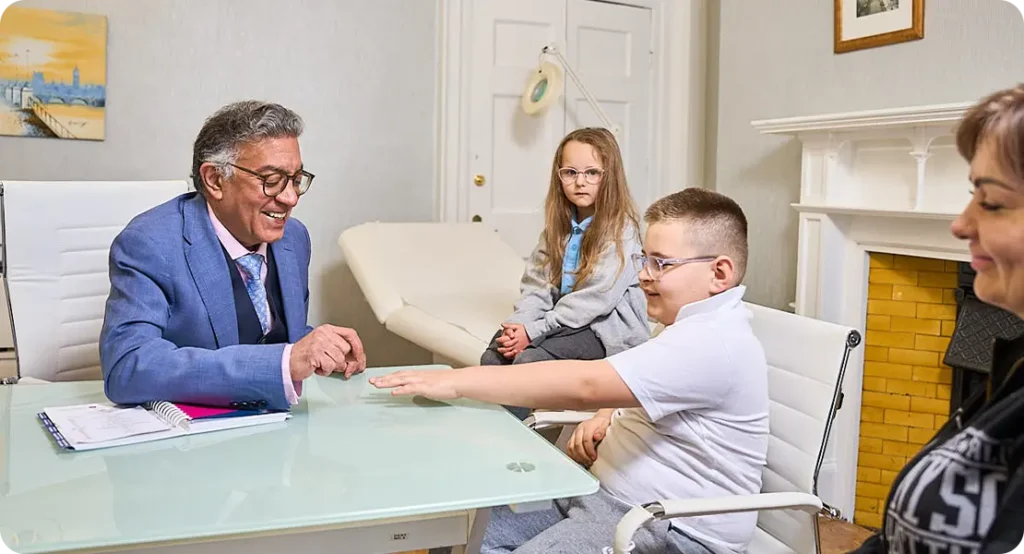Paediatric psoriasis, long viewed as simply a juvenile form of the adult condition, is now increasingly recognised by researchers and clinicians as a distinct clinical entity with its own unique biological, genetic, and immunological features. Affecting nearly 1% of children worldwide, this chronic inflammatory skin disorder can significantly disrupt not just physical health, but also emotional wellbeing, particularly as it often emerges during key developmental stages such as early childhood or adolescence. The condition frequently causes red, itchy, scaly plaques that can be both uncomfortable and highly visible leading to social anxiety, bullying, or low self-esteem in young patients.
Fortunately, recent advances in genetic research and immunological understanding have revolutionised how we view and manage paediatric psoriasis. Through sophisticated techniques like genome-wide association studies (GWAS), cytokine pathway analysis, and biomarker identification, scientists are beginning to unravel the complex mechanisms that underpin the onset and progression of the disease in children. These discoveries have paved the way for the development of more targeted, safer, and effective treatments, including paediatric-approved biologic therapies.
In this article, we explore how the latest genetic and immunological insights are reshaping paediatric psoriasis care. From breakthrough research on immune pathways to the rise of precision-targeted treatments and multidisciplinary care models, we’ll uncover what today’s clinicians and families need to know to navigate this complex condition and offer children a better, brighter future.
1. Understanding the Basics of Paediatric Psoriasis
Paediatric psoriasis is a chronic inflammatory skin condition marked by red, scaly plaques, most commonly found on the scalp, elbows, knees, and trunk. While it shares clinical features with adult psoriasis, its course, triggers, and treatment responses often differ significantly. Many children also experience psychological distress related to the visibility of lesions and peer perception.
Psoriasis in children is typically classified as plaque, guttate, pustular, or inverse, with plaque psoriasis being the most prevalent. Early-onset disease may also be linked with stronger genetic predispositions, including a family history of psoriasis or autoimmune disorders. Proper diagnosis often requires differentiation from similar-looking skin conditions like eczema or fungal infections.
Though not contagious, paediatric psoriasis can be persistent and difficult to manage without early intervention. It can also serve as a precursor to more severe forms in adulthood. A comprehensive approach to treatment includes both physical and emotional support.
2. Role of the IL-23/Th17 Pathway
The IL-23/Th17 axis is central to the pathogenesis of psoriasis in both adults and children. IL-23 promotes the differentiation of Th17 cells, which secrete IL-17—a cytokine that stimulates keratinocyte proliferation. In paediatric psoriasis, this pathway is often highly active.
Targeting IL-17 or IL-23 has proven effective in reducing disease severity. Drugs like ustekinumab and secukinumab are now approved for adolescent use. These therapies provide relief by disrupting key signalling cascades.
Ongoing research is exploring how early intervention in this pathway could prevent long-term disease progression. By controlling inflammation early, it may be possible to alter the disease course. The IL-23/Th17 pathway continues to be a major focus in therapeutic development.
3. Biologic Therapies for Children

Biologic therapies are a newer class of treatments that target specific parts of the immune system, offering highly effective disease control for moderate to severe cases. Drugs such as etanercept, adalimumab, and ixekizumab have shown significant promise in clinical trials. They work by inhibiting specific cytokines like TNF-alpha and IL-17.
These medications are usually reserved for children who don’t respond well to traditional therapies or who have extensive body surface involvement. Regular blood tests and monitoring are essential to ensure safety. In many cases, biologics provide rapid, sustained symptom relief and improved quality of life.
Long-term studies are underway to assess their safety profiles in paediatric populations. So far, the results have been encouraging, with minimal severe adverse events reported. As more data becomes available, the use of biologics in paediatric care is expected to become more widespread.
4. Topical Treatments and First-Line Therapy
Topical treatments remain the frontline option for managing mild to moderate paediatric psoriasis due to their ease of application and relatively low side-effect profile. Commonly used agents include corticosteroids, vitamin D analogues like calcipotriol, and calcineurin inhibitors such as tacrolimus. These are applied directly to the skin and can be tailored to the affected body areas.
Success depends heavily on correct application technique, treatment consistency, and close parental supervision. Overuse of topical steroids can cause skin thinning or striae, particularly in sensitive areas like the face or groin. Rotational regimens and combination creams help reduce these risks while maintaining effectiveness.
Newer formulations, such as foam sprays and dual-action creams, have improved ease of use and patient adherence. These innovations are particularly helpful for treating scalp or large surface areas. Despite newer systemic options, topicals still play a crucial role in early disease management.
5. Phototherapy in Paediatric Psoriasis
Phototherapy, particularly narrowband UVB (NB-UVB), is a proven treatment for children with moderate psoriasis who haven’t responded adequately to topicals. It works by slowing the rapid production of skin cells and reducing inflammation. NB-UVB is favoured over broadband UVB and PUVA due to its favourable safety profile.
Treatment involves attending specialised clinics 2–3 times per week for a few months. Eye protection, dose regulation, and skin assessments are critical parts of the protocol. Children typically tolerate phototherapy well with minimal discomfort.
Although effective, the long-term use of phototherapy must be monitored due to potential cumulative effects like photoaging or increased skin cancer risk. Nevertheless, it remains a highly effective and safe method when administered under dermatological supervision. It’s often used as a bridge to systemic therapy.
6. Psychological Support and Quality of Life
The visible nature of psoriasis and its chronicity can significantly impact a child’s mental health. Children may experience embarrassment, bullying, or isolation, especially when lesions affect exposed areas like the face or arms. Emotional distress can, in turn, trigger flares and reduce treatment compliance.
Comprehensive care should include routine mental health screening and psychological counselling where needed. Support groups and peer interaction can help children feel less alone. School-based education also helps normalise the condition among classmates.
Parental understanding and involvement are key to managing both the emotional and physical effects. Educational resources empower families to handle challenges confidently. Addressing mental health alongside physical symptoms leads to more successful outcomes.
7. Nutritional and Lifestyle Factors

There is growing evidence that lifestyle factors can influence psoriasis severity and frequency of flare-ups in children. Obesity is particularly relevant, as it’s associated with systemic inflammation and reduced response to treatment. Encouraging a healthy diet and regular exercise is essential for holistic care.
Although specific diets like gluten-free or anti-inflammatory diets are sometimes promoted, clinical evidence supporting their use in children remains limited. However, some families report subjective improvement. Nutritional planning should be individualised and supervised by a dietitian.
Other important lifestyle considerations include adequate sleep, stress management, and avoiding known environmental triggers. Good hydration and proper skin moisturisation also help maintain barrier function. These habits support overall skin health and improve treatment outcomes.
8. Comorbidities and Early Detection
Children with psoriasis may be at risk for associated health conditions such as psoriatic arthritis, obesity, and metabolic syndrome. Early signs of joint stiffness, fatigue, or weight gain should prompt further evaluation. Detecting these issues early helps prevent long-term damage.
Routine screening for comorbidities should be part of ongoing care. Blood tests, imaging, and growth monitoring are often used. Collaboration between dermatologists, paediatricians, and rheumatologists ensures comprehensive management.
Recognising and managing comorbidities not only improves physical outcomes but also boosts overall quality of life. It enables a holistic view of the child’s wellbeing. Integrating this into care plans is becoming a global best practice.
9. Psoriatic Arthritis in Children
Paediatric psoriatic arthritis (PsA) is a less common but serious condition linked to childhood psoriasis. It involves joint pain, swelling, and reduced mobility. Early signs can be subtle and are sometimes mistaken for growing pains.
Diagnosis relies on physical exams, blood tests for inflammation markers, and imaging such as ultrasound or MRI. Left untreated, PsA can lead to joint deformities. Early diagnosis and intervention are critical.
Biologic treatments used for skin symptoms also help control arthritis. Methotrexate is another common option for joint involvement. Multidisciplinary care involving rheumatology is vital.
10. The Role of Microbiome in Paediatric Psoriasis
Emerging research has linked skin and gut microbiomes to psoriasis development. Children with psoriasis may show reduced microbial diversity. Certain bacteria appear more frequently in flares.
Disruptions in gut flora could trigger systemic inflammation, influencing skin symptoms. This connection is still under study but may offer new treatment avenues. Probiotics and diet modification may play a future role.
Understanding the microbiome could pave the way for targeted therapies. Trials are ongoing to evaluate microbiome-focused treatments. It’s a promising area of paediatric dermatology research.
11. The Importance of Early Diagnosis
Delayed diagnosis of psoriasis in children can result in worsening symptoms and more aggressive disease later. Many cases are initially misidentified as eczema or dermatitis. Clear diagnostic criteria help reduce delays.
Dermatologists use a combination of clinical observation and family history to make accurate assessments. Skin biopsies are rarely needed but may be used in uncertain cases. Educating general practitioners improves early recognition.
Quicker diagnosis leads to earlier treatment, which can stop disease progression. It also alleviates the psychological burden on the child. Raising awareness is key to timely intervention.
12. School and Social Support for Affected Children
School life can be difficult for children with visible skin conditions. Teasing and exclusion are unfortunately common. Schools should provide inclusive environments and support policies.
Teachers and staff must be educated about the condition to reduce stigma. Flexible dress codes, private changing areas, and access to moisturisers help. Support from school counsellors can also be useful.
Peer awareness sessions can promote empathy and understanding. When school and family work together, children thrive. An inclusive environment improves confidence and performance.
13. Advances in Paediatric Clinical Guidelines

Recent years have seen an update in clinical guidelines specifically for children with psoriasis. These include new recommendations for biologic eligibility, topical use, and combination therapy strategies. Guidelines are increasingly informed by paediatric clinical trials.
Clear age-specific dosing and monitoring protocols now exist for many therapies. This enhances safety and effectiveness. Guidelines also include criteria for stepping up or switching treatments.
International organisations are working to standardise care globally. These updates help ensure consistent, evidence-based management. Families benefit from more predictable treatment experiences.
14. Adherence to Treatment Plans
Adherence is a common challenge in managing chronic conditions like psoriasis. Children may resist applying creams or attending frequent appointments. Parental supervision is key to maintaining routines.
Using reward systems or integrating treatment into daily habits can improve compliance. Educating children about their condition empowers them to participate. Healthcare providers should offer practical tips.
Teledermatology may also help maintain continuity of care. Remote check-ins reduce travel time and increase convenience. Creative solutions support better long-term outcomes.
15. Vaccination Considerations for Immunosuppressed Children
Children on immunosuppressive treatments like biologics must follow specialised vaccination schedules. Live vaccines may not be safe during therapy. Coordination with paediatricians ensures proper immunisation planning.
Flu and COVID-19 vaccines are strongly encouraged for children with psoriasis. These help reduce infection risk during flare-ups or active treatment. Doctors assess timing and appropriateness case by case.
Patient records should be up to date and reviewed during clinic visits. Educating parents on safe vaccines enhances compliance. Preventive care is a vital part of chronic disease management.
16. Cultural and Ethnic Considerations
Psoriasis can present differently across skin tones, which may affect diagnosis and treatment response. In darker skin, lesions may appear purple or brown instead of red. This requires cultural competence in care.
Delayed diagnosis in ethnic minorities is an ongoing issue. Education and training help healthcare providers recognise variant presentations. Tailored resources can support better communication.
Inclusion in clinical trials ensures therapies are effective across populations. Awareness of ethnic nuances leads to better outcomes. Equitable care must be a standard goal.
17. Future Directions in Research and Therapy
Ongoing research is focusing on personalised medicine, digital monitoring, and immune pathway modulation. Genetics, microbiome science, and wearable tech are shaping the future. Treatments are becoming more precise.
Artificial intelligence may soon support early diagnosis and treatment tracking. Combined with telehealth, this can revolutionise care delivery. Digital apps can help families manage the condition day-to-day.
As new drugs and strategies emerge, children with psoriasis can expect safer and more effective options. Early detection, innovation, and education remain at the heart of progress. The future holds real promise for long-term disease control.
Final Thoughts: Personalised, Safe and Supportive Care
Childhood psoriasis can present significant emotional and physical challenges, not just for the children affected but also for their families. However, with the continuous evolution of medical science, managing this chronic condition has become more effective and less disruptive to daily life. Advancements in targeted therapies, enhanced understanding of genetic and environmental triggers, and an emphasis on holistic care are transforming the treatment landscape. Today, children living with psoriasis can enjoy improved skin health, enhanced self-esteem, and a better overall quality of life. This condition no longer needs to define a child’s identity, limit their activities, or hinder their long-term potential.
Successful treatment of paediatric psoriasis relies on a team-based, multidisciplinary approach. Close collaboration between dermatologists, paediatricians, psychologists, and family members ensures that each child receives care tailored to their individual needs. A thoughtful, age-appropriate, and compassionate treatment plan—grounded in the latest clinical evidence—can make a world of difference. Early recognition of symptoms, prompt access to medical care, and ongoing emotional support are essential for achieving the best possible outcomes.
If you’re concerned about your child’s skin health, we encourage you to reach out to us at The London Dermatology Centre. Book a consultation with one of our experienced paediatric dermatologists and take the first step toward expert, personalised care designed to support your child’s health and happiness.
References:
- Bronckers, I.M.G.J., Seyger, M.M.B., West, D.P. and Lara-Corrales, I., 2017. A practical approach to topical treatment in children with psoriasis. Journal of the American Academy of Dermatology, 76(2), pp.223–230.
- Augustin, M., Kirsten, N., Reich, K., Radtke, M.A. and Schaefer, I., 2021. Epidemiology and burden of disease in paediatric psoriasis: A population-based study. British Journal of Dermatology, 185(3), pp.581–589. Available at: https://onlinelibrary.wiley.com/doi/full/10.1111/bjd.19890
- Eichenfield, L.F., Ahluwalia, J., Barbarot, S., Lara-Corrales, I., Torres, T., Vender, R. and Benfeldt, E., 2020. It’s not just the skin: Recognising the burden of paediatric psoriasis. Clinical Therapeutics, 42(6), pp.1136–1146.
- Henseler, T. and Christophers, E., 1985. Disease concomitance in psoriasis. Journal of the American Academy of Dermatology, 13(3), pp.450–456.
- Nestle, F.O., Kaplan, D.H. and Barker, J., 2009. Psoriasis. New England Journal of Medicine, 361, pp.496–509. Available at: https://doi.org/10.1056/NEJMra0804595 (DOI source)
